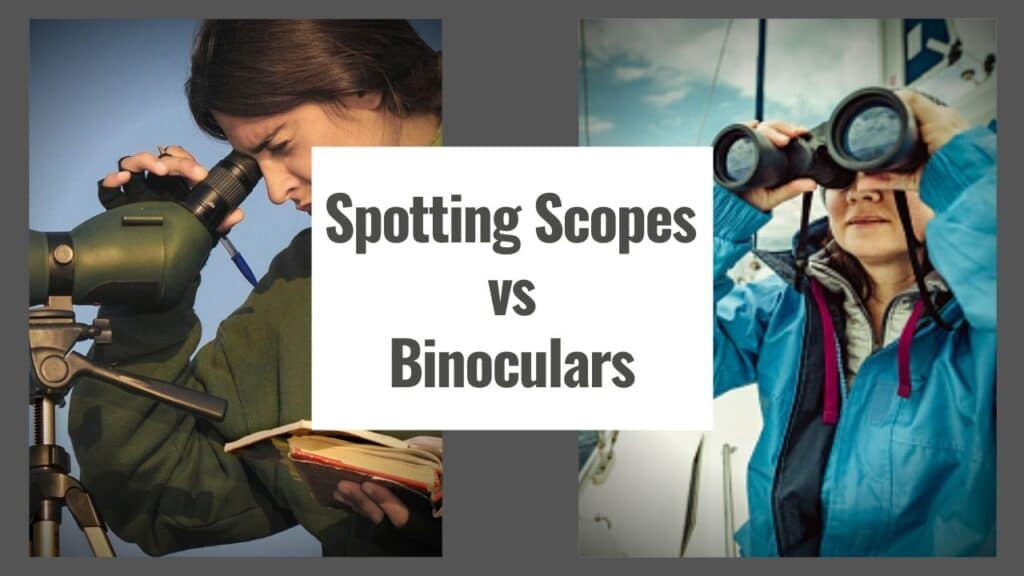Spotting Scopes vs Binoculars
Spotting Scopes vs Binoculars: When buying a first device, many optics lovers faced the problem of choosing – which is better, Spotting Scopes or Binoculars?
At first glance, one can assume that working with a two-eyed device is more practical; however, not everything is so obvious. In this article, we will talk about the differences between spotting scopes and binoculars. So let’s get started.

Table of Contents
Binoculars
Binoculars are a more popular choice due to their portability. They are usually in the 8-by 42 or 10×42 configuration, and this is the standard size.
You can store them in a backpack or even in your pocket. But they have lower magnifications. Indeed, they have almost fixed magnification. But there are some exceptions. Zoom binoculars variable magnification, and it usually ranges from 8 or 7 to 15. But these are usually really low in quality.
However, with binoculars, you need to use both eyes, which is more natural. So you get more comfortable. And so, binoculars are rarely placed on a tripod.
Read More – How to Choose Binoculars for Hunting
Binocular Construction
Binoculars are rubberized and comfortable with a natural grip. It brings closer the observed objects. We usually look through its eyepiece. It is a complex construction of several lenses glued together.
They are most commonly equipped with three, five, or seven lens eyepieces. The more lenses, the less distortion the binoculars produce, but the price of the device increases.
The second mandatory component of the optical system is the lens. The reversing system consists of several prisms. The picture is transferred from plane to plane. As a result, a person sees the image not upside down but in its normal form. The best binoculars are equipped with high-quality, fully coated glass optics.
Spotting Scope
Spotting scopes are always acceptable for target shooting. In general, most spotting scopes are bigger than binoculars. You only need to use one eye with the spotting scopes, so there’s always some strain.
Likewise, they have bigger magnifications, starting at 30 and then moving from up to 100. As the magnification is higher, thus you need additional support.
So most spotting scopes also come with an attachment for the tripod. Therefore, spotting scopes are always mounted on a tripod or leaned against something like a rock or tree branch.
Scope Construction
Most spotting scopes are built in a classic telescopic design with a lens, eyepiece, and lens reversing system. You can easily recognize them by their straight design and long length.
The more powerful such a tube, the greater its magnification and the diameter of the objective, the longer it is. To make these pipes more convenient during transportation, they are made sliding.
Although classic telescopic pipes have better characteristics, there has been a noticeable increase in fixed pipes, using a mirror or prismatic wrapping systems to achieve compactness in recent years.
Read More – 7 Reasons to Choose a Spotting Scope
Common Features of Binocular and Spotting Scope
Both binoculars and spotting scope comes with a water-resistant coating. Several manufacturers produce binoculars and spotting scopes with a host of additional options and features.
If desired, you can select devices that respond to thermal radiation, effectively working at night, digital binoculars and optical tubes with a built-in camera, laser rangefinder, compass, and reticle for calculating the distance to the inspected object.
Furthermore, many manufacturers offer a protective case with a shoulder strap or a metal case for storage and transport, complete with binoculars or a scope. Even high-magnification spotting scopes are most often equipped with tripods as well.
Spotting Scope vs Binoculars
Unlike binoculars, observation through scopes requires one eye, which is undoubtedly not so convenient, but the purpose of the telescopes is somewhat different.
Observation through binoculars is carried out mainly “from the hands,” while most scopes, except for compact “pocket” models with a lower magnification, are mounted on a tripod.
Moreover, it is rare to find models with a large exit pupil diameter and a large aperture ratio among the spotting scopes. For most devices, these indicators are minimized, and such a characteristic as a high magnification comes to the fore.
If for binoculars, the magnification of 20-30 is considered too high, then the scopes have a magnification of 30, 50, and even 60. Thus, it is easy to imagine the primary purpose of scopes is to observe very distant or small objects with the maximum possible magnification. For example – observing targets in a shooting range.
In contrast, binoculars are not very suitable for this. It gives a good panorama, a comfortable picture, convenient for observation for a long time. But it is difficult to see where the bullet hit, while one glance into a powerful scope mounted on a tripod is enough to get complete information.
Read More – Monocular VS Binocular
Binoculars or Spotting Scope: What to Choose?
While binoculars have a wider field of view, spotting scopes provide more far-sightedness. Binoculars are great for seeing fine details from a distance, but higher magnification can cause blurring.
Therefore, young explorers, who require high magnification devices, use spotting scope with stabilizing support (tripod). But, if you’re a bird watcher, you can use binoculars to observe and inspect the bird from more close.
Final Verdict
In a nutshell, the choice between the spotting scope and binocular entirely relies on the purpose of usage. Mostly binoculars are suitable for bird watching, spectator sports viewing, astronomy, and wildlife viewing.
In comparison, spotting scopes are suitable for target shooting and hunting. We have covered some good information regarding binocular and scope in this article. Here we are wrapping up now. We hope this article will help you to decide between binocular and spotting scope for your need.
Read More:







